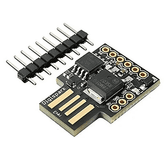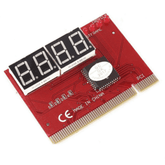Difference Between Sensor and Transducer
Summary
Have you ever walked into a room and the lights turned on automatically? Or perhaps your smartphone screen dims when you enter a dark space. These seemingly magical interactions are the work of tiny, unsung heroes embedded in the devices all around us. They form the bridge between the physical world and the digital realm, allowing machines to perceive and react to their surroundings.
Two terms you'll often hear in this context are "sensor" and "transducer." While they are frequently used as synonyms, they describe distinct, albeit closely related, functions. Understanding their roles is key to appreciating the intricate engineering behind our modern technology. This post will demystify these components, explore what each one does, and clarify their relationship once and for all.

What is a Sensor?
A sensor is a device whose purpose is to detect events or changes in its environment. Think of it as the sensory organ of a machine. Just as your eyes detect light and your skin detects pressure, a sensor detects a specific physical quantity and responds to it. This quantity could be anything from temperature, light, and motion to humidity, pressure, or the presence of a specific chemical. The primary job of a sensor is simply to sense a particular condition.

For example, the thermostat on your wall contains a temperature sensor. Its sole job is to measure the ambient temperature of the room. A motion-activated security light uses a passive infrared (PIR) sensor to detect the body heat of a person walking by. In these examples, the sensor is the component that performs the initial detection.
The output from a sensor is a signal that corresponds to the physical property it has detected. This signal isn't always electrical; in an old-fashioned mercury thermometer, the physical expansion and rising of the mercury in the glass tube is the signal, directly indicating the temperature.
More commonly in modern electronics, this initial detection produces a signal that needs to be converted into a form that a microprocessor or other electronic circuit can understand, which is where its relationship with transducers becomes important. Both Sensors and transducers are fundamental building blocks of modern measurement and control systems.
Key Functions of a Sensor
- Detection: This is the fundamental purpose of a sensor. It is designed to be sensitive to a specific form of physical stimuli. A photodiode, for instance, is built to detect the presence and intensity of light. Without this primary ability to perceive a change, the device would not be a sensor.
- Measurement: A sensor goes beyond simple binary detection (e.g., light or no light). It provides a quantifiable measurement of the stimulus. It can determine how much light is present, how hot it is, or how much pressure is being applied. This quantitative output is what makes sensors so useful for data collection and control.
- Signaling: Upon detecting and measuring a physical property, the sensor produces a corresponding output signal. This signal is a representation of the measured quantity. The nature of this signal can vary widely, from a change in electrical resistance or voltage to a mechanical movement or a change in frequency.
What is a Transducer?

A transducer is a device that converts energy from one form to another. This is a much broader definition than that of a sensor. The key concept here is energy conversion. A transducer takes an input signal in one energy form and creates an output signal in a different energy form. The forms of energy can include electrical, mechanical, chemical, optical, thermal, and acoustic, among others.
A classic example of a transducer that isn't a sensor is a loudspeaker. It takes electrical energy (the audio signal from your amplifier) and converts it into mechanical energy (the vibration of the speaker cone), which then creates acoustic energy (the sound waves you hear). Another common example is a light bulb, which converts electrical energy into light and heat energy.
In both cases, the device is performing an energy conversion, but it is not "sensing" a property of its environment. The relationship between the two concepts can be subtle, because many sensors rely on a transducer to function.
In fact, many people argue that transducers can be sensors when they are used to detect a physical quantity. For example, a microphone is a transducer that converts acoustic energy (sound waves) into electrical energy (an audio signal). Because its primary use is to detect sound, it functions as a sound sensor.
Key Functions of a Transducer
- Energy Conversion: This is the defining function of a transducer. Its core role is to change one type of energy into another. A solar panel is a transducer that converts light energy into electrical energy. A motor is a transducer that converts electrical energy into mechanical motion.
- Signal Transformation: The process of energy conversion inherently involves transforming a signal. A transducer is responsible for ensuring that the output signal accurately represents the input signal, but in a different energy domain. For instance, in a thermocouple, the output voltage must be directly proportional to the measured temperature difference.
- Input/Output Interface: Transducers act as critical interfaces between different parts of a system or between a system and the real world. They can take a signal from a sensor and convert it into something a computer can process, or they can take a signal from a computer and convert it into a physical action, like a motor turning a shaft. Those that cause a physical action are often called actuators.
Difference Between Sensor and Transducer
Now that we have explored each component, let's directly address the difference between a sensor and a transducer. The main distinction lies in their fundamental purpose and scope. A sensor's purpose is to detect a change in the physical environment. A transducer's purpose is to convert energy from one form to another. From this, a key relationship emerges: a sensor often contains or is a type of transducer, but a transducer is not necessarily a sensor.
To put it another way, a sensor senses, and a transducer converts. The act of sensing almost always requires an energy conversion to produce a usable signal, which is why a sensor is considered a type of transducer. For example, a digital temperature sensor detects heat (a physical property) and uses an internal transducer element (like a thermistor) to convert that thermal energy change into a change in electrical resistance.
The entire package is called a "temperature sensor." Conversely, a loudspeaker is a transducer because it converts electrical energy to sound, but it doesn't sense anything about its environment, so it is not a sensor. The difference between a transducer and a sensor becomes clearer when looking at components that are only one or the other.
The following table highlights the core differences between transducers and sensors:
| Feature | Sensor | Transducer |
|---|---|---|
| Primary Function | Detects a physical quantity or change in the environment. | Converts one form of energy into another. |
| Scope | A specific type of device focused on detection. | A broad category of devices focused on energy conversion. |
| Relationship | A sensor is a type of transducer or contains a transducer element. | Not all transducers are sensors. |
| Example (Sensor Only) | A bimetallic strip that bends with heat to trip a switch. The strip is the sensor. | A loudspeaker, which converts electrical signals to sound but does not detect anything. |
| Example (Both) | A microphone, which detects sound (sensing) and converts it to an electrical signal (transduction). | A thermocouple, which detects temperature (sensing) and converts it to a voltage (transduction). |
| Role in a System | Acts as the "input" or detector for a system. | Can be an input (like a sensor), an output (like an actuator/motor), or an intermediary processor. |
In many modern electronic systems, the terms for Sensors and transducers are used interchangeably because most electronic sensors are, by definition, transducers. They sense a physical phenomenon and convert it into an electrical signal. However, maintaining the distinction is important for precision in engineering and science. The sensor is the complete package that performs the measurement (e.g., a pressure sensor), while the transducer is the specific element within it that handles the energy conversion.
Conclusion
In essence, a sensor is a detector, and a transducer is a converter. While their functions are intertwined, they are not the same. Every sensor must convert the property its measuring into a signal, a process that relies on transduction, making every sensor a transducer. However, not every device that converts energy is used for detection, so not every transducer is a sensor.
A light bulb and a motor are perfect examples of transducers that do not sense their environment. Understanding this distinction helps clarify the roles these crucial components play in the technology that shapes our world, from the simple automatic faucet in a public restroom to the complex inertial navigation systems that guide aircraft across the globe. They are the silent, diligent workers that give our machines the ability to perceive, measure, and interact with the world around them.






